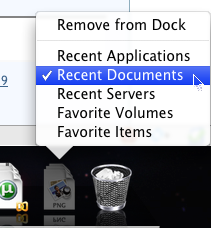How To Hide A File From Recents On Mac

There are plenty of good reasons you might want to hide some of your files or folders. Maybe you carry around a laptop and you just want to be extra safe. Maybe you share an account with others and need to keep some things private. Whatever the reason, here are eight ways to do it in OS X. 1: Enable FileVaultThis is probably the simplest way to do it.
Aug 01, 2014 1. Click on the Apple icon in the upper left-hand corner of the screen. Scroll down to the 'Recent Items' tab. Hold the mouse arrow over the tab and a list of the most recent applications and documents you have opened will appear. Scroll the mo. Some apps may show a list of recent files at the bottom of the File menu instead. After you find the document, you can tag it, or drag it to a new location. See also See and organize your files in the Finder on Mac Ways to quickly see items in the Finder on Mac Recover files using Time Machine and Spotlight on Mac Narrow your search results on Mac.
Go to System Preferences’ Security & Privacy pane and turn on FileVault. That will encrypt your entire hard drive, so someone would need your password to get at its contents. 2: Hide them in the LibraryAssuming your /Library folder is hidden (that’s the default in OS X Mountain Lion), hold down the Option key as you open the Finder’s Go menu. Navigate to that Library folder, then create a new folder there or just drag the files or folders you want to hide into it. 3: Put them in another user accountCreate a new user in System Preferences’ Users & Groups preference pane, then put the files and folders you want to hide in that account. 4: Make the file/folder hidden 1In Terminal, type chflags hidden and then drag a folder or file you want to hide into the Terminal window; you can still access those hidden folders and files by summoning the Go To Folder dialog (Command-Shift-G) and typing in their full paths.
Power consumption calculator in boat. Thank you for your patience and understanding. You can also use our webshop to order online or over the phone. Please NOTE: ALL pre-existing and new purchases need to be pre-ordered, phone, with a time arranged with RPC staff prior to pick-up. Goods will be dispatched via Australia Post and couriers; additional safety precautions for goods handling have been put in place.Our show room is currently closed, however, appointments can be made by phone so we can prepare orders for pick up from our premises.
To unhide them, go back to Terminal and type chflags nohidden followed by the file or folder path. 5: Make the file/folder hidden 2Again in Terminal, type mv filename.filename. This moves the original folder to one with a period at the beginning of its name; by default, folders with periods at the beginning of their names are hidden in OS X.

You can also type mkdir.hiddenfolder to create a new hidden folder. In either case, you can again access the hidden folder using the Go To Folder option. 6: Hide in plain sightUse innocent-sounding filenames such as Cat videos January 2013— LOL! Instead of something more intriguing ( Top secret).
7: Set visibility attribute to invisibleIf you have installed, go to Terminal and enter setfile -a V followed by the name of the file or folder. That sets its visibility attribute to invisible; you can undo this by repeating the command with a lower-case v. 8: Use a third-party solutionTry Apimac’s or Altomac’s.So that’s it: Eight different ways to hide files or folders in OS X. Thanks to writer Steve McCabe for the tips. You’ll find those and more in the story “100 More Things Every Mac User Should Know” in the April issue of Macworld.